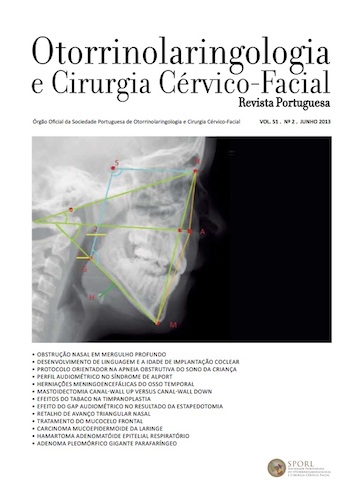Management of meningoencephalic herniation of the temporal bone at Egas Moniz Hospital
DOI:
https://doi.org/10.34631/sporl.19Keywords:
meningoencephalic herniation, Cerebrospinal fluid leakage, temporal bone, tegmen defect, surgical approachesAbstract
The meningoencephalic herniations of the middle ear through a defect in the temporal bone are a rare and potentially fatal condition. The preferred treatment is the surgical repair of the meningoencephalic defect in order to prevent meningitis and enable the restoration of hearing. In this paper we present five case of meningoencephalic herniations treated at the Department of Otorhinolaryngology, Egas Moniz Hospital. The interest of these cases relates to the pathogenesis and the surgical options. All patients in the study had a minimal follow-up of 3 months and all had a surgical cure of the meningoencephalic herniation and hearing improvement. The meningoencephalic herniations associated to cerebrospinal fluid leakage in the temporal bone in adulthood are uncommon. An otologic surgeon must be able to make the diagnosis and according to his surgical experience treat or refer the patient.
Downloads
References
Gurkanlar D, Akyuz M, Acikbas C, Ermol C, et al. Difficulties in treatment of CSF leakage associated with a temporal meningocele. Acta Neurochirurgica. 2007; 149: 1239-1242.
Lundy Larry B, Graham M, kartush J, LaRouere M. Temporal Bone Encephalocele and Cerebrospinal Fluid Leaks. Am J Otol. 1996;17:461-469.
Goddard J, Meyer T, Nguyen S, Lambert P. New Consinderations in the Cause of Spontaneous Cerebrospinal Fluid Otorrhea. Otol Neurol. 2010; 31: 940-945.
Sanna M, Paolo F, Russo A, Falcioni M. Management of Meninencephalic Herniation of the Temporal Bone: Personal Experience and Literature Review. Laryngoscope. 2009; 119:1579-1585.
Feenetra L, Sanna M, Zini C, Gamoletti R, et al. Surgical Treatment of Brain Herniation into the Middle Ear and Mastoid. The American J Otol. 1985; volume 6, number 4.
Gray B, Willinsky R, Rutka J, Tator C. Spontaneous Meningocele, a Rare Middle Ear Mass. Am Soc Neuroradiol. Jan 1995;16:203-207.
Gubbels S, Selden N, Delashaw J, McMenomery S. Spontaneous Middle Fossa Encephalocele and Cerebrospinal Leakage: Diagnosis and Management. Otol Neurol. 2007; 28:1131-1139.
Bovo R, Ceruti S, Padovani R, Martini A. Temporal Bone Brain Herniation-Imaging case of the month. OtolNeurol. 2006; 27: 576-577.
Fisch U, Mattox D. Microsurgery of the skull base. New York: Thieme Medical Publishers, Inc.; 1988.
Fisch U. Infratemporal fossa approach for lesions in the temporalbone and base of the skull. Adv Otorhinolaryngol. 1984;34:254-66.






